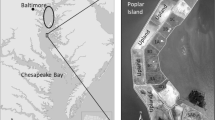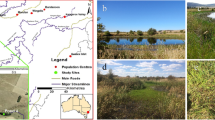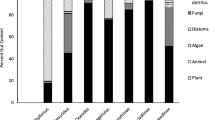Abstract
Allochthonous subsidies of organic material can profoundly influence population and community structure; however, the role of consumers in the processing of these inputs is less understood but may be closely linked to community and ecosystem function. Inputs of drift macrophytes subsidize sandy beach communities and food webs in many regions. We estimated feeding rates of dominant sandy beach consumers, the talitrid amphipods (Megalorchestia corniculata, in southern California, USA, and Talitrus saltator, in southern Galicia, Spain), and their impacts on drift macrophyte subsidies in field and laboratory experiments. Feeding rate varied with macrophyte type and, for T. saltator, air temperature. Size-specific feeding rates of talitrid amphipods were greatest on brown macroalgae (Macrocystis, Egregia, Saccorhiza and Fucus). Rates for large individuals of both species ranged from ∼40 mg wet wt individual−112 h−1 on brown macroalgae to negligible feeding by M. corniculata on a vascular plant (surfgrass). Amphipod growth rates were also greatest on Macrocystis and lowest on surfgrass, Phyllospadix. For a Californian beach with substantial inputs of macrophyte wrack (>70 kg wet wt m−1 month−1 in summer), we estimated that the population of talitrid amphipods could process an average of 55% of the palatable Macrocystis input. Our results indicate that talitrid amphipod populations can have a significant impact on drift macrophyte processing and fate and that the quantity and composition of drift macrophytes could, in turn, limit populations of beach consumers.








Similar content being viewed by others
References
Adin R, Riera PR (2003) Preferential food source utilization among stranded macroalgae by Talitrus saltator (Amphipod, Talitridae): a stable isotopes study in the northern coast of Brittany (France). Estuar Coast Shelf Sci 56:91–98
Anderson WB, Polis GA (1999) Marine subsidies of island communities in the Gulf of California: evidence from stable carbon and nitrogen isotopes. Oikos 81:75–80
Bärlocher F, Newell SY (1994) Phenolics and proteins affecting palatability of Spartina leaves to the gastropod Littorina irrorata. Pubbl Staz Zool Napoli I Mar Ecol 15:65–75
Barrett K, Anderson WB, Wait DA, Grismer LL, Polis GA, Rose MD (2005) Marine subsidies alter the diet and abundance of insular and coastal lizard populations. Oikos 109:145–153
Bustamante RH, Branch GM, Eekhout S (1995) Maintenance of an exceptional intertidal grazer biomass in South Africa:subsidy by intertidal kelps. Ecology 76:2314–2329
Chown SL (1996) Kelp degradation by Paractora trichosterna (Thomson) (Diptera: Helcomyzidae) at sub-Antarctic South Georgia. Polar Biol 16:171–178
Colombini I, Chelazzi L (2003) Influence of marine allochthonous input on sandy beach communities. Oceanogr Mar Biol Annu Rev 41:115–159
Craig PC (1973) Behavioral and distribution of the sand-beach amphipod Orchestoidea corniculata. Mar Biol 23:101–109
Cross WF, Wallace JB, Rosemond AD, Eggert SL (2006) Whole-system nutrient enrichment increases secondary production in a detritus-based ecosystem. Ecology 87:1556–1565
Dayton PK (1985) Ecology of kelp communities. Annu Rev Ecol Syst 16:215–245
Denton A., Chapman ARO (1991) Feeding preferences of gammarid amphipods among four species of Fucus. Mar Biol 109:503–506
Dugan JE, Hubbard DM, McCrary MD, Pierson MO (2003) The response of macrofauna communities and shorebirds to macrophyte wrack subsides on exposed sandy beaches of southern California. Estuar Coast Shelf Sci 58S:25–40 doi:10.1016/S0272-7714(03)0045-3
Graça MA, Newell SY, Kneib RT (2000) Grazing rates of organic matter and living fungal biomass of decaying Spartina alterniflora by three species of salt-marsh invertebrates. Mar Biol 136:281–289
Griffiths CL, Stenton-Dozey JME (1981) The fauna and rate of degradation of stranded kelp. Estuar Coast Shelf Sci 12:645–653
Griffiths CL, Stenton-Dozey JME, Koop K (1983) Kelp wrack and energy flow through a sandy beach. In: McLachlan A, Erasmus T (eds) Sandy beaches as ecosystems. W. Junk, The Hague, pp 547–556
Hayes WB (1974) Sand beach energetics: importance of the isopod Tylos punctatus. Ecology 55:838–847
Hobday AJ (2000) Abundance and dispersal of drifting kelp, Macrocystis pyrifera rafts in the Southern California Bight. Mar Ecol Prog Ser 195:101–116
Hubbard DM, JE Dugan (2003) Shorebird use of an exposed sandy beach in southern California. Estuar Coast Shelf Sci 58S:169–182
Incera M (2004) Influencia de los factores ambientales sobre la macrofauna y la composición bioquímica del sedimento en intermareales arenosos. PhD Dissertation, University of Vigo, Spain. 299 pp
Inglis G (1989) The colonization and degradation of stranded Macrocystis pyrifera (L.) by the macrofauna of a New Zealand sandy beach. J Exp Mar Biol Ecol 125:203–217
Jaramillo E, McLachlan A (1993) Community and population responses of the macroinfauna to physical factors over a range of exposed sandy beaches in south-central Chile. Estuar Coast Shelf Sci 37:615–624
Jaramillo E, De la Huz C, Duarte E, Contreras H (2006) Algal wrack deposits and infaunal arthropods on sandy beaches of the Chilean coast. Rev Chil Hist Nat 79:337–351
Jędrzejczak MF (2002) Stranded Zostera marina L. vs wrack fauna community interactions on a Baltic sandy beach (Hel, Poland): a short-term pilot study. Part II. Driftline effects of succession changes and colonisation by beach fauna. Oceanologia 44:367–387
Johnston M, Johnston D, Richardson A (2005) Digestive capabilities reflect the major food sources in three species of talitrid amphipods. Comp Biochem Physiol Biochem Mol Biol 140:251–257
Kirkman H (1984) Standing stock and production of Ecklonia radiata (C. Ag.) J. Agardh. J Exp Mar Biol Ecol 76:119–130
Kneib RT, Newell SY, Hermeno ET (1997) Survival, growth and reproduction of the salt marsh amphipod Uhlorchestia spartinophila reared on natural diets of senescent and dead Spartina alterniflora leaves. Mar Biol 128:423–431
Koop K, Lucas MI (1983) Carbon flow and nutrient regeneration from the decomposition of macrophyte debris in a sandy beach microcosm. In: McLachlan A, Erasmus T (eds) Sandy beaches as ecosystems. W. Junk, The Hague, pp 249–262
Lastra M, De la Huz R, Sánchez Mata AG, Rodil IF, Aerts K, Beloso S, López J (2006) Ecology of exposed sandy beaches in northern Spain: environmental factors controlling macrofauna communities. J Sea Res 55:128–140
Lopez GR, Levinton JS, Slobodkin LB (1977) The effect of grazing by the detritivore Orchestia grillus on Spartina litter and its associated microbial community. Oecologia 30:111–127
Marsden ID (1991) Kelp-sandhopper interactions on a sand beach in New Zealand. I. Drift composition and distribution. J Exp Mar Biol Ecol 152:61–74
McLachlan A, Brown AC (2006) The ecology of sandy shores. 2nd edn, Academic Press, Amsterdam, 392 pp
Moore PG, Francis CH (1985) Some observations on food and feeding of the supralittoral beach hopper Orchestia gammarellus (Pallas) (Crustacea: Amphipoda). Ophelia 24:183–197
Moran JAG, Arrontes J (1994) Factors affecting food preference in a widespread intertidal isopod. J Exp Mar Biol Ecol 182:111–121
Nardi M, Morgan E, Scapini F (2003) Seasonal variation in the free running period in two Talitrus saltator populations from Italian beaches differing in morphodynamics and human disturbance. Estuar Coast Shelf Sci 58s:199–206
Orr M, Zimmer R, Jelinski DE, Mews M (2005) Wrack deposition on different beach types: spatial and temporal variation in the pattern of subsidy. Ecology 86:1496–1507
Pennings SC, Carefoot TH, Zimmer M, Danko JP, Ziegler A (2000) Feeding preferences of supralittoral isopods and amphipods. Can J Zool 78:1918–1929
Peterson CH, Renaud PE (1989) Analysis of feeding preference experiments. Oecologia 80:82–86
Polis GA, Hurd SD (1996) Linking marine terrestrial food webs: allochthonous input from the ocean supports high secondary productivity on small islands and coastal land communities. Am Nat 147:396–423
Robertson AI, Lucas JS (1983) Food choice, feeding rates and turnover of macrophyte biomass by a surf-zone inhabiting amphipod. J Exp Mar Biol Ecol 72:99–124
Scapini F, Chelazzi L, Colombini I, Fallaci M (1992) Surface activity, zonation and migrations of Talitrus saltator on a Mediterranean beach. Mar Biol 112:145–157
Short AD, Wright LD (1983) Physical variability of sandy beaches. In: McLachlan A, Erasmus T (eds) Sandy beaches as ecosystems. W. Junk, The Hague, pp 133–144
Steinberg PD (1988) Effects of quantitative and qualitative variation in phenolic compounds on feeding in three species of marine invertebrate herbivores. J Exp Mar Biol Ecol 120:221–237
Steinberg PD, van Altena I (1992) Tolerance of marine invertebrate herbivores to brown algal phlorotannins in temperate Australasia. Ecol Monogr 62(2):189–222
Stenton-Dozey JM, Griffiths CL (1983) The fauna associated with kelp stranded on a sandy beach. In: McLachlan A, Erasmus T (eds) Sandy beaches as ecosystems. W. Junk, The Hague, pp 557–568
Tarr JG, Tarr PW (1987) Seasonal abundance and the distribution of coastal birds on the northern Skeleton Coast, South West Africa/Namibia. Madoqua 15:63–72
Taylor RB, Brown PJ (2006) Herbivory in gammarid amphipod Aora typica: relationships between consumption rates, performance and abundance across ten seaweed species. Mar Biol 149(3):455–463
Valiela I, Rietsma CS (1984) Nitrogen, phenolic acids and other feeding cues for salt marsh detritivores. Oecologia 63:350–356
Van Alstyne KL, McCarthy JJ III, Hustead CL, Kearns LJ (1999) Phlorotannin allocation among tissues of northeastern Pacific kelps and rockweeds. J Phycol 35:483–492
Van Alstyne KL, Whitman SL, Ehlig JM (2001) Differences in herbivore preferences, phlorotannin production and nutritional quality between juvenile and adult tissues from marine brown algae. Mar Biol 139:201–210
Wakefield RL, Murray SN (1998) Factors influencing food choice by the seaweed-eating marine snail Norrisia norrisi (Trochidae). Mar Biol 130:631–642
Acknowledgments
This study was supported by bursaries from the University of Vigo (to M.L., H.M.P. and I.F.R.) the Xunta de Galicia (Predoctorales Xunta P.P. 0000 300S 140.08 to I.F.R.), the National Sea Grant College Program of the US Department of Commerce (NOAA grant #NA06RG0142), the California Sea Grant program (Project R/CZ-174) and the Santa Barbara Coastal LTER (NSF # OCE-99–82105). We thank D. Chakos, R. Fisher, J. Hoesterey, M. James, M. Lippincott, J. Tarmann, and N. Wenger for their assistance with the field and laboratory work. The authors declare that all the experiments carried out in this paper comply with the current laws from Spain and USA.
Author information
Authors and Affiliations
Corresponding author
Additional information
Communicated by U. Sommer.
Rights and permissions
About this article
Cite this article
Lastra, M., Page, H.M., Dugan, J.E. et al. Processing of allochthonous macrophyte subsidies by sandy beach consumers: estimates of feeding rates and impacts on food resources . Mar Biol 154, 163–174 (2008). https://doi.org/10.1007/s00227-008-0913-3
Received:
Accepted:
Published:
Issue Date:
DOI: https://doi.org/10.1007/s00227-008-0913-3




